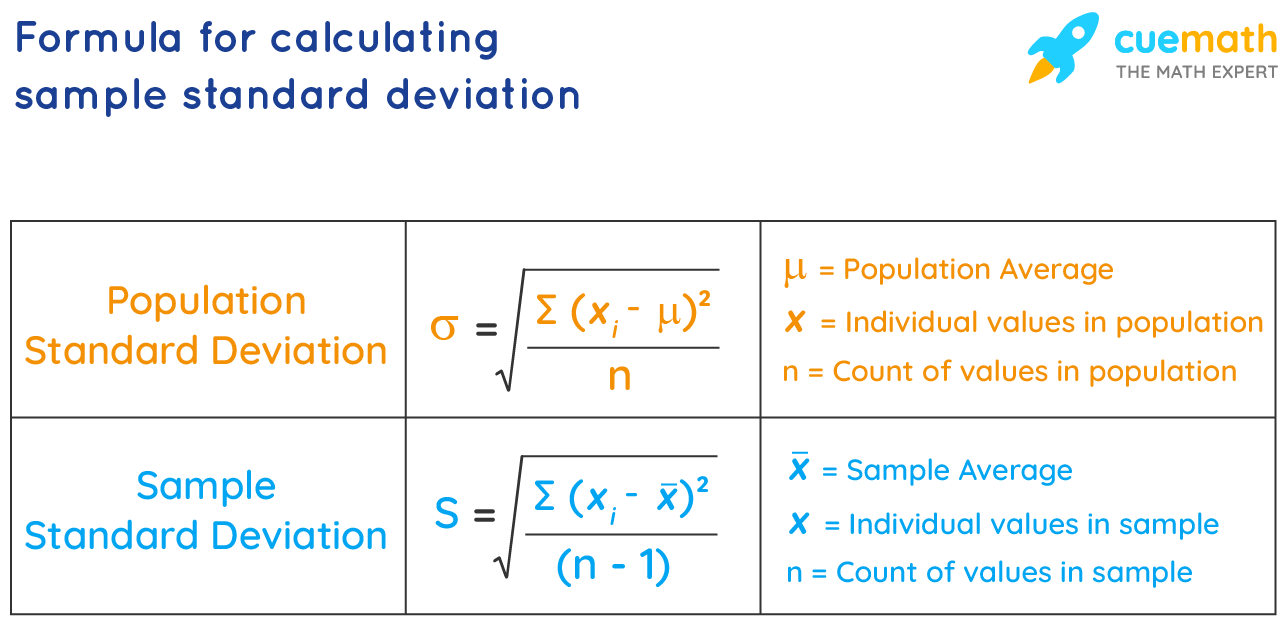Sample Standard Deviation Formula
Before learning the sample standard deviation formula, let us see when do we use it. In a practical situation, when the population size N is large it becomes difficult to obtain value xi for every observation in the population and hence it becomes difficult to calculate the standard deviation (or variance) for the population. In such cases, we can estimate the standard deviation by calculating it on a sample of size n taken from the population of size N. This estimated variance is called the sample standard deviation(S). Since a sample standard deviation is a statistic that is calculated from only a few individuals in a reference population. The sample has greater variability and thus the standard deviation of the sample is almost always greater than that of the population. Let us explore the sample standard deviation formula below.
What Is the Sample Standard Deviation Formula?
There are two types of standard deviations, population standard deviation, and sample standard deviation. While calculating the population standard deviation, we divide by n, the number of data values. For calculating the sample standard deviation, we divide by n -1 i.e., one less than the number of data values. Given a sample of data (observations) for the random variable x, its sample standard deviation formula is given by:
\(S = \sqrt{\dfrac{1}{n-1} \sum^{n}_{i=1}(x_i - \bar{x})^2} \)
Here,
- \(\overline{x}\) = sample average
- x = individual values in sample
- n = count of values in the sample

The steps for calculating the sample standard deviation are:
- Calculate the mean (simple average of the numbers).
- For each number: subtract the mean and square the obtained result.
- Sum up all of the squared results.
- Divide this sum by one less than the total number of data points (n - 1). This will give us the sample variance.
- Take the square root of this value to get the sample standard deviation.

Let us see the applications of the sample standard deviation formula in the below-solved examples.
Examples Using Sample Standard Deviation Formula
Example 1: In the data set 9, 6, 8,5, 7, find the sample standard deviation.
Solution:
n = 5
Mean = (\(\bar{x}\)) = (9+6+8+5+7)/ 5
= 35/5 = 7
Using the sample standard deviation formula,
S = \( \sqrt{\dfrac{\Sigma (x_i-\bar{x})^2}{N-1}} \) = \( \sqrt{\dfrac{(9-7)^2 +(6-7)^2 +(8-7)^2 +(5-7)^2 +(7-7)^2}{4}} \)
= √10/4 = √2.5 = 1.58
Answer: Sample Standard Deviation for this data is 1.58
Example 2: There are 45 students in a class. 5 students were randomly selected from this class and their weights(in kg) were recorded as follows:
| 51 | 38 | 79 | 46 | 57 |
Calculate the sample standard deviation of their weights.
Solution:
N = 5
Mean (\(\bar{x}\))= \(\dfrac{51+38+79+46+57}{5}\) = 54.2 kg
Using the sample standard deviation formula,
S = \( \sqrt{\dfrac{\Sigma (x_i-\bar{x})^\!2}{N-1}} \) = \( \sqrt{\dfrac{(51\!-\!54.2\!)\!^\!2\! +\!(\!38\!-\!54.2\!\!)\!^\!2\! +\!\!(\!79\!\!-\!54.2\!)\!\!^\!2\!\! +\!\!(\!46\!-\!54.2\!)\!^\!2\! +\!(57\!-\!54.2)^2}{4}} \) = 15.5
Answer: Sample Standard Deviation for this data is 15.5
Example 3: Calculate the sample standard deviation for the data set 4, 7, 9, 10, 16.
Solution: Given that, data set: 4, 7, 9, 10, 16.
Mean = (4 + 7 + 9 + 10 + 16) / 5 = 46/5 = 9.2
Sample Standard Deviation Formula is given by the S = √1/n−1 ∑ni=1(xi − x̄)2
Here, x̄ = sample average, x = individual values in sample, n = count of values in the sample.
On substituting the values, we get
S = √1/n−1 ∑ni=1(xi − x̄)2
S = √1/5−1 {(4 - 9.2)2 + (7 - 9.2)2 + (9 - 9.2)2 +(10 - 9.2)2 + (16 - 9.2)2}
S = √1/4 {(-5.2)2 + (-2.2)2 + (-0.2)2 + (0.8)2 + (6.8)2}
S = √1/4 {27.04 + 4.84 + 0.4 + 0.64 + 46.24}
S = √1/4 (78.8)
S = √19.7
S = 4.4
Answer: Sample Standard Deviation for this data is 4.4
FAQs on Sample Standard Deviation Formula
What Is the Sample Standard Deviation Formula?
A sample standard deviation is a statistic that is calculated from only a few individuals in a reference population. The sample has greater variability and thus the standard deviation of the sample is almost always greater than that of the population.
What Is the Standard Deviation Formula for a Sample vs Population?
While calculating the population standard deviation, we divide by n, the number of data values. For calculating the sample standard deviation, we divide by n -1 i.e., one less than the number of data values.
What Is the Standard Deviation's Formula in Sample Size?
The standard deviation of the sample means the standard error. Standard deviation tells us how accurate the mean of any given sample is compared with respect to the reference population's mean.
Why Do We Use Standard Deviation Formula and Variance Formula?
Standard deviation looks at how spread out a group of numbers is from the mean, by looking at the square root of the variance. The variance measures the average degree to which each point differs from the mean—the average of all data points.
What Is the Relationship Between the Variance and the Standard Deviation for a Sample Data Set?
The relationship between the variance and the standard deviation for a sample data set is given below:
- Variance represents the average squared deviations from the mean value of data, while standard deviation represents the square root of that number.
- Both, the variance and the standard deviation measures reflect variability in a distribution.
- Both have different units like the standard deviation has the same units as the original values like minutes or meters while the variance has much larger units like meters squared.
- The variance is equal to the square of standard deviation or the standard deviation is the square root of the variance. V = σ2
visual curriculum
